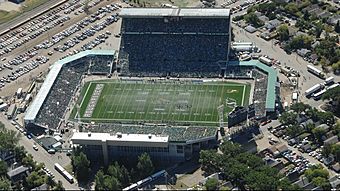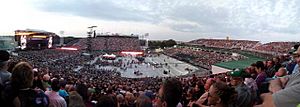Taylor Field (Regina, Saskatchewan) facts for kids

Mosaic Stadium in its final configuration.
|
|
| Former names | Park de Young (1936–1946) |
|---|---|
| Location | 1910 Piffles Taylor Way P.O. Box 1966 Regina, Saskatchewan S4P 3E1 (now replaced by the new Mosaic Stadium) |
| Owner | Saskatchewan Roughriders football club |
| Capacity | Football: 33,427 (55,438 with temporary seating) |
| Record attendance | 55,438 (Oct 14, 1995 vs Calgary Stampeders) |
| Surface | Dirt (1936–1946) Grass (1946–1978) 3M Tartan Turf (1979–1987) OmniTurf (1988–1999) AstroTurf (2000–2006) FieldTurf (2007–2016) |
| Construction | |
| Opened | October 21, 1936 |
| Renovated | 1936, 1978–79, 2005–06, 2012–13 |
| Closed | November 5, 2016 |
| Demolished | October 27, 2017 |
| Tenants | |
| Saskatchewan Roughriders (CFL) (1936–2016) Regina Rams (U Sports) Regina Thunder (CJFL) Regina High School Football Regina Riot (WWCFL) |
|
Taylor Field, later known as Mosaic Stadium at Taylor Field, was a well-known outdoor stadium in Regina, Saskatchewan. It was the home field for the Saskatchewan Roughriders football team for many years. This team plays in the Canadian Football League (CFL).
The stadium was used from 1936 until 2016. However, a sports field had been on that spot since 1910. The Roughriders started playing there as early as 1921. At first, the stadium was mainly for baseball, with football as a second sport. But in 1966, it became a stadium just for football.
Taylor Field was also home to other teams. These included the University of Regina Rams, the Regina Thunder, and the Regina Riot. High school football games were also played there. The city of Regina owned and managed the stadium. It had an artificial turf field and could hold over 32,000 fans.
The stadium closed after the 2016 football season. A new stadium, also called Mosaic Stadium, took its place. The old Taylor Field was taken down in 2017. The area where it stood is now being turned into new buildings and spaces.
History of Taylor Field
Early Days and Name Changes
The stadium was in the North Central part of Regina. The very first sports field on this spot was called Park Hughes. It was built in 1910 for rugby, which is similar to Canadian football.
The Regina Rugby Club, which later became the Roughriders, started in 1910. They played their first game at Park Hughes in 1921. At that time, the field was very basic, mostly just dirt. If it rained a lot, the field would turn into mud. The team sometimes had to play games at other places, like the RCMP barracks. In 1924, the team chose the nickname "Roughriders."
In 1928, Park Hughes joined with a nearby baseball field called Park de Young. The combined area was named Park de Young. A football field was set up there. In 1936, a permanent concrete grandstand with 5,000 seats was built. The team then played all their games there for the next 80 years. Lights were added in 1937.
For ten years, the playing field remained dirt. New topsoil was added each year. Games often became dusty or muddy depending on the weather. Finally, in 1946, a grass surface was planted.
Renaming to Taylor Field
In 1947, the stadium was renamed Taylor Field. It was named after Piffles Taylor, who had recently passed away. Neil J. "Piffles" Taylor was a brave pilot in the First World War. He was also a lawyer and played and coached football in Regina. He even led the Regina Roughriders as president.
Piffles Taylor was known for being very tough. He lost an eye in the war but still played football in the 1920s. Once, during a game, his artificial glass eye popped out when he was tackled! Everyone stopped playing to help him find it. After he cleaned it and put it back in, the game continued.
Changes and Upgrades Over Time
When the stadium was first built, baseball was very popular. But as Major League Baseball became popular on TV, fewer people went to local baseball games. So, in 1966, a second grandstand was built. This greatly increased the number of seats for Roughriders games. It also turned Taylor Field into a stadium just for football.
In 1978 and 1979, more renovations happened. About 7,000 seats were added with a new upper section. The natural grass field was replaced with artificial turf. This artificial turf was updated several times over the years. In 2005, a new scoreboard with a giant replay screen was installed.
In 2006, the stadium got new washrooms, food stands, and better seats. A new sound system was also added. In 2007, the field was changed to a newer type of artificial turf called FieldTurf. Taylor Field was the last CFL stadium to use the older type of artificial turf.
Mosaic Stadium at Taylor Field
On June 23, 2006, the Roughriders and The Mosaic Company made a deal. The company paid money for the stadium to include their name. This is called naming rights. The stadium was then called Mosaic Stadium at Taylor Field. They decided to keep "Taylor Field" in the name to honor its history.
Because so many people wanted to see games, temporary seats were often added. For example, in 2008, over 2,000 extra seats were put in for some games. This brought the total capacity to over 30,000 fans.
In 2012, the Roughriders announced a big renovation plan. This was called the "Legacy Project." It prepared the stadium to host the 101st Grey Cup game. The upgrades included 7,000 extra seats and new corporate suites. More bathrooms and food stands were added. The video screen was also upgraded to a huge 60-foot LED display.
Memorable Events at Taylor Field
Sports Highlights
- Taylor Field hosted the Grey Cup championship game three times. These were in 1995, 2003, and 2013. For these big games, many extra temporary seats were added.
- The stadium also hosted field hockey games for the 2005 Canada Games.
- Some of the longest field goals in CFL history happened at Taylor Field. This was partly because Regina can be very windy.
- In 1987, Dave Ridgway kicked a 60-yard field goal. This was the first time a field goal was made from that distance in CFL history.
- In 2001, Paul McCallum broke that record with a 62-yard field goal.
Concerts and Shows
Taylor Field was not just for sports. Many famous music artists performed there.
| Date | Artist(s) | Opening act(s) | Tour | Additional notes |
|---|---|---|---|---|
| October 6, 2006 | Rolling Stones | Three Days Grace | A Bigger Bang | Both shows sold out very quickly. |
| October 8, 2006 | ||||
| August 24, 2009 | AC/DC | — | Black Ice World Tour | Tickets sold out in less than an hour. |
| July 28, 2010 | Bon Jovi | Kid Rock | The Circle Tour | The music video for "This Is Our House" was filmed here. |
| August 14, 2013 | Paul McCartney | — | Out There | This was his first concert in Regina. The City of Regina Pipe Band joined him for a song. |
A concert by Aerosmith was planned for August 9, 2009. However, it was cancelled because the singer, Steven Tyler, got hurt.
A New Stadium for Regina
Building the New Mosaic Stadium
On July 12, 2012, leaders from Saskatchewan and Regina announced a plan. They would build a brand new stadium for the Roughriders. This new stadium would be located at Regina's exhibition grounds.
Taylor Field hosted its last Roughriders game on October 29, 2016. The very last football game played there was a university semi-final game the following week. The Roughriders moved to the new Mosaic Stadium for the 2017 season.
Demolition of Taylor Field
In 2017, many items from the old stadium were sold at an auction. This happened before the stadium was taken down. The demolition of Taylor Field began in September 2017. The tallest part of the stadium, the west grandstand, was taken down on October 27, 2017.
See also
- List of Canadian Football League stadiums


